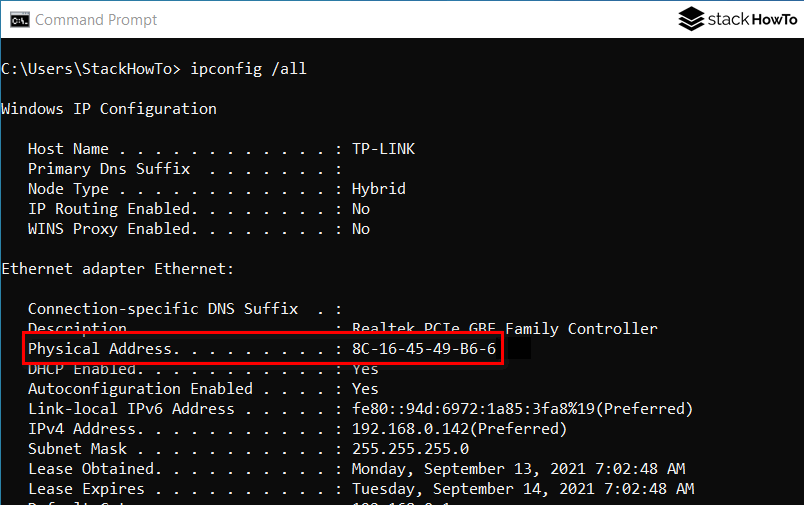

- Network mac address command prompt how to#
- Network mac address command prompt Bluetooth#
- Network mac address command prompt windows#
You will find this in IEEE 802 networking technologies, and this includes the likes of Ethernet, Wi-Fi, and Bluetooth. It is basically a unique identifier given to a network interface controller for use as a network address in communications within a network sector. MAC address stands for media access control address.
Network mac address command prompt how to#
How to locate the MAC address via the Command Prompt. How can I find the MAC address via Settings?.  Other names used to describe a MAC address. The information below will help you better understand the MAC address and all that it entails, so keep reading. In this article, we are going to explain what a MAC address is along with how it works.
Other names used to describe a MAC address. The information below will help you better understand the MAC address and all that it entails, so keep reading. In this article, we are going to explain what a MAC address is along with how it works. Network mac address command prompt Bluetooth#
Your MAC address is labeled Ethernet ID or MAC Address, and should be six groups of two letters and numbers, separated by colons.Have you ever tried to search for a Bluetooth device nearby, or even attempt to identify one or more devices on a network? When you do this, you’re actually dealing with a MAC address without knowing it. This screen may look slightly different depending on whether you selected Built-in Ethernet or Wi-Fi in the previous step. On the resulting screen, look on the tabs across the top for the Ethernet or Hardware tab. For your wireless MAC address, select Wi-Fi or Airport, and then click Advanced. For your wired MAC address, select Built-in Ethernet, and then click Advanced. In the resulting network window, there will be network interfaces listed on the left. In the System Preferences window, click on Network. Click on the Apple icon in the top left, and click on System Preferences, or open System Preferences from your Dock. The Mac address will be displayed next to Physical address and is a 12 character alpha numeric string. Select Ethernet from the left hand side and select your Ethernet interface on the right hand side. Once the Settings page opens click on Network & Internet. In the screenshots below, it is Local Area Connection for Wired and Wireless Network Connection (MIT) for Wireless. For the interface you are trying to obtain the MAC address for (wired or wireless), click on the link on the left-hand column under View your active networks next to Connections. Open the Start Menu and open the Control Panel. Please note that it may be necessary to scroll up if you have many network devices. For your wireless IP address, look for a section labeled "Wireless LAN adapter Wireless Network Connection." Again, your MAC address is labeled "Physical Address", and is a 12 character alpha numeric string. Your MAC address is labeled "Physical Address", and is a 12 character alpha numeric string. 
If so they will be labeled Local Area Connection 2, Local Area Connection 3, etc.
There may be more than one Local Area Connection. For your wired MAC address, look for a section labeled "Ethernet Adapter Local Network Connection.". Result: This will bring your IP configuration in a verbose format. Result: This will bring up the Command Prompt. Click the cmd (Command Prompt) icon in the results. Go to the Start menu and in the Search box, type cmd. There will just be cosmetic differences in the actual screens displayed. Network mac address command prompt windows#
Note: The screenshots below in this section are from Windows 7, however the same steps will also apply to Windows 10. NOTE: Each machine has its own unique MAC address. You will see the MAC address Listed beside "Physical Address (MAC). Locate the the adapter you want to find the MAC address for in the list (such as "Wireless Network Adapter" for your Wi-Fi Connection). When this opens, navigate to the Network and InternetĢ.) In the Network & Settings, click on "Advanced Network Settings, then select "Hardware and Connections Properties"ģ.) In Hardware and Connection Properties, you will see a list of information about all the network adapters installed on your PC. 1.) Open Settings by pressing Windows+I key on your keyboard.







 0 kommentar(er)
0 kommentar(er)
